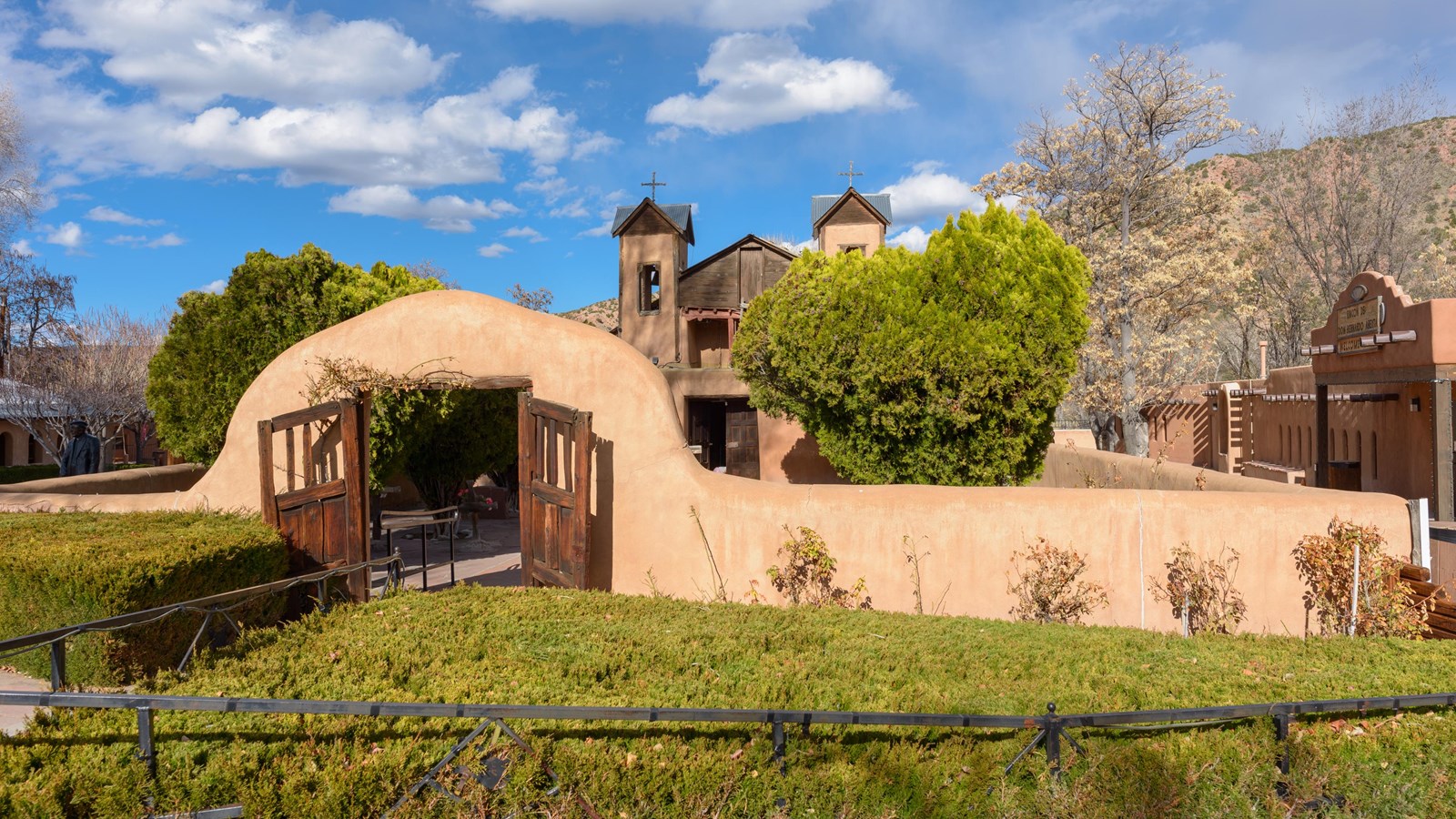Last updated: March 23, 2024
Place
El Santuario de Chimayo

NPS Photo
Historical/Interpretive Information/Exhibits
El Santuario de Chimayo, a small shrine located in the Sangre de Cristo Mountains of Chimayo, New Mexico, and near the path of the Old Spanish Trail, has been a place of worship since before its construction in 1813. For generations people of faith have traveled to the site of El Santuario to ask for healing for themselves and others, and to offer prayers of petition and of thanksgiving for favors received. Following a long tradition of miraculous shrines, El Santuario is now one of the most important Catholic pilgrimage centers in the United States and one of the most beautiful examples of Spanish Colonial architecture in New Mexico.
Today El Santuario de Chimayo, also known as Lourdes of America, attracts over 300,000 pilgrims from all over the Southwest and elsewhere each year. Thousands of pilgrims walk to El Santuario from Santa Fe and other starting points during Holy Week.
Pueblo Indians have inhabited the Chimayo area since the 12th century, long before the initial Spanish conquest of New Mexico. When they arrived, the Spanish committed to converting the natives to Christianity, which became a major point of friction between the Catholic Church and the American Indians. In 1680, the Pueblo Indians revolted temporarily ending Spanish commitment to the region.
The Tewa Indians named Chimayo as “Tsi-Mayoh,” after one of four sacred hills above the valley, which lies directly behind El Santuario de Chimayo. The Pueblo Indians believed that they shared their land with supernatural beings. The natives thought the healing spirits were to be found in the form of hot springs, which ultimately dried up leaving the healing earth. The Pueblo and Tewa used the site of El Santuario de Chimayo for healing long before Spanish occupation.
In 1693, led by Diego de Vargas, the Spanish returned to reconquer New Mexico. The Spanish regained control of the area, creating a perpetual flow of Spanish and Mexican settlers to northern New Mexico. The returning and newly arrived Hispanic families dispersed along the Santa Cruz River and in the village of El Potrero, the future site of the shrine. By 1805, commitment to a miraculous Guatemalan image of Christ crucified known as Our Lord of Esquipulas had become popular in El Potrero.
Devotion to Our Lord of Esquipulas originated at an early colonial shrine in Guatemala, at which the earth was said to be effective in curing illnesses. Franciscan friars spread commitment to this image of Christ crucified throughout Mexico and to New Mexico. The people of El Potrero passed on a series of legends concerning the apparition of Our Lord of Esquipulas from generation to generation in the Chimayo area. According to the most popular tradition, on the Holy Week night of Good Friday in 1810, Don Bernardo Abeyta, a member of the Penitentes, saw a light beaming out of one of the hills near the Santa Cruz River in Chimayo. He went to the spot and saw that the light was coming out of the ground. Digging with his bare hands, he found a Crucifix, which he immediately associated with Our Lord of Esquipulas. He left it there and a group of men went to notify the priest, Fray Sebastián Alvarez.
The priest set out for Chimayo and carried the Crucifix back to his church in Santa Cruz, placing it in the niche of the main altar. The next morning, the Crucifix was gone and found in its original location in Chimayo. This same process was repeated two more times, and the Crucifix always ended up back in its original location thus making it apparent that Our Lord of Esquipulas wanted to reside in Chimayo. Another legend claims that Don Bernardo Abeyta had a vision while plowing his fields that directed him to dig beneath his plow where he would find earth with great healing powers.
In 1813, on behalf of the residents of El Potrero, Abeyta petitioned the priest for permission to build a chapel dedicated to Our Lord of Esquipulas on what the people believed to be the site of the miraculous Crucifix or earth with healing powers. The miraculous healings grew so numerous it required replacing the chapel with the larger, current shrine in 1816. The healings started as a result of the miraculous earth or sand found under the shrine. It is said that the earth at Chimayo can be mixed with water to make mud and eaten or applied to the skin in order to heal a person of an ailment. Some people take vials of the sand with them as a remembrance of their pilgrimage to Chimayo.
(Adapted from the Latino American Heritiage Travel Itinerary)
Site Information
Location (On NM 76 (the High Road) in the town of Chimayo, NM)
El Santuario de Chimayo sits in the center of the small village of El Potrero, one of several settlements in the Santa Cruz Valley collectively called Chimayo. El Santuario de Chimayo is a well preserved small adobe church with twin front towers with belfries, wooden doors, a wall-enclosed garden, and an arched gate with a cross on top. The interior is a colorful mixture of Spanish and Indian decorations and styles. The nave of the church is decorated with original astonishing examples of 19th century Hispanic religious folk art, including several santos and religious frescoes. Behind the altar stands the miraculous statue of Our Lord Esquipulas. On the left side of the nave are two separate rooms.
El Santuario remained in the ownership of the descendants of Bernardo Abeyta until 1929, when the Spanish Colonial Arts Society in Santa Fe that writer Mary Austin, artist Frank Applegate and architect/preservationist John Gaw Meem headed, purchased it from the family and donated it to the Archdiocese of Santa Fe.
Safety Considerations
